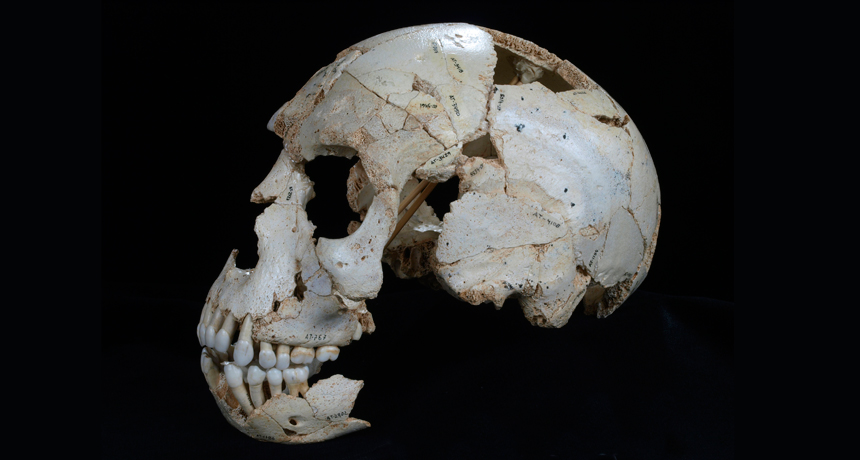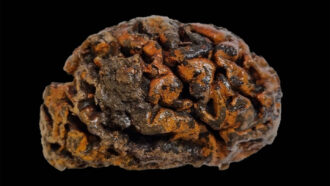Neandertal ancestor?
Ancient skulls suggest a long path to Neandertals

This 400,000-year-old skull has features typical of Neandertals. But the brain that would fit inside it would have been smaller than the average Neandertal brain. This suggests the skull came from related folk that lived before the Neandertals.
© JAVIER TRUEBA/MADRID SCIENTIFIC FILMS
A clutch of skulls found deep inside a Spanish cave look a lot like Neandertals, an ancient humanlike species. But the shape of these skulls is not quite what scientists would expect from a Neandertal. Such a mix of features suggests that this species, which lived long before Neandertals, was related to them. The new findings also suggest Neandertals went through a long and complicated evolution.
The oldest known true Neandertals lived about 200,000 years ago. (The oldest human remains, for comparison, also date back some 200,000 years.) The 17 skulls analyzed for the new study came from far more ancient hominids: These pre-human folk lived roughly 430,000 years ago. Their skulls provide the oldest evidence of Neandertal-like features, says Juan Luis Arsuaga. This paleontologist led the new study. He works at Complutense University of Madrid, in Spain.
The newfound skulls had protruding teeth and no chin. Those Neandertal-like features suggest these ancient folk used their mouths — like tools — to hold onto things. This ability may have been important to the survival of Neandertals, Arsuaga told Science News. He and his coworkers describe their findings in the June 20 Science.
Like all living things, Neandertals evolved from an earlier species. That means they changed, probably slowly, over long stretches of time. The skulls in Spain came from a species that lived long before proper Neandertals — but they probably had a common ancient ancestor. The new study suggests that the Neandertal species evolved through many twists and turns. The newly analyzed skulls belonged to one species that popped up during that evolution.
Indeed, the skulls that ended up in a Spanish cave may have come from one of many species that arose and went extinct long before true Neandertals, says Jean-Jacques Hublin. An anthropologist not involved in the new study, he works at the Max Planck Institute for Evolutionary Anthropology in Leipzig, Germany.
The brain case — the rear part of the skull that holds the brain — was rather small in the 430,000-year-old folk, says Hublin. Both humans and Neandertals have large brain cases. The newly analyzed skulls suggest that humans and Neandertals may have evolved their big brains in different ways, Hublin says. Over time, those differences may have led humans to success — and Neandertals to extinction.
Arsuaga says the bones raise other questions, too. They showed up at a site now called Sima de los Huesos, or “pit of bones.” But scientists don’t know how the ancient bones got there.
No populations as old as these pre-Neandertals are known to have practiced end-of-life rituals, such as burying their dead, Arsuaga points out. So how did these ancient bones end up in a Spanish cave? “Someone, some agent had to put them there,” he told Science News. But who or what is responsible? That, he says, is “a problem that is very difficult to solve.”
Power Words
adaptation A process by which an organism or species becomes better suited to its environment. When a community of organisms does this over time, scientists refer to the change as evolution.
anthropology The study of humankind. A social scientist who studies different societies and cultures is called an anthropologist.
brain case The rear part of a skull that holds and protects the brain.
evolution A process by which species undergo changes over time, usually through genetic variation and natural selection. These changes usually result in a new type of organism better suited for its environment than the earlier type. The newer type is not necessarily more “advanced,” just better adapted to the conditions in which it developed.
extinction The state or process of a species, family or larger group of organisms ceasing to exist.
fossil Any preserved remains or traces of ancient life. There are many different types of fossils: The bones and other body parts of dinosaurs are called “body fossils.” Things like footprints are called “trace fossils.” Even specimens of dinosaur poop are fossils.
hominid A primate of an animal family that includes humans and their fossil ancestors.
Neandertal A species (Homo neanderthalensis) that lived in Europe and parts of Asia from about 200,000 years ago to roughly 28,000 years ago.
paleontologist A scientist who specializes in studying fossils, the remains of ancient organisms.
species A group of similar organisms capable of producing offspring that can survive and reproduce.







